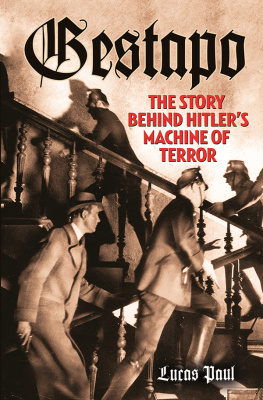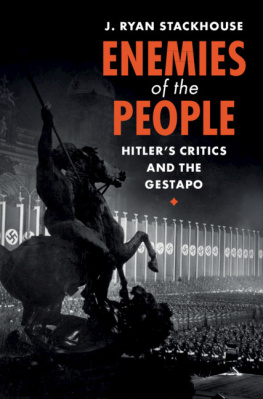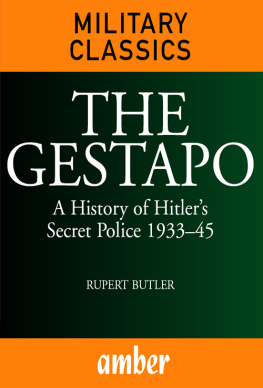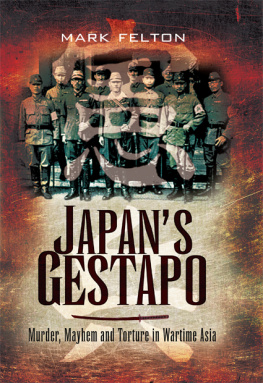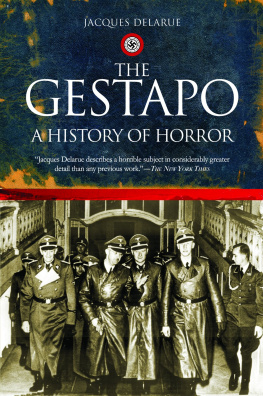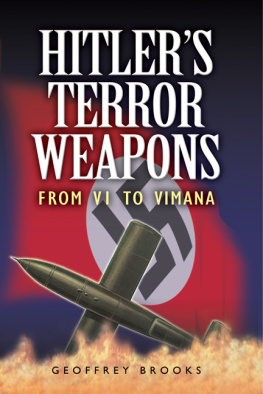Lucas Saul - Gestapo : Hitlers Secret Terror Police
Here you can read online Lucas Saul - Gestapo : Hitlers Secret Terror Police full text of the book (entire story) in english for free. Download pdf and epub, get meaning, cover and reviews about this ebook. year: 2015, genre: Non-fiction. Description of the work, (preface) as well as reviews are available. Best literature library LitArk.com created for fans of good reading and offers a wide selection of genres:
Romance novel
Science fiction
Adventure
Detective
Science
History
Home and family
Prose
Art
Politics
Computer
Non-fiction
Religion
Business
Children
Humor
Choose a favorite category and find really read worthwhile books. Enjoy immersion in the world of imagination, feel the emotions of the characters or learn something new for yourself, make an fascinating discovery.
- Book:Gestapo : Hitlers Secret Terror Police
- Author:
- Genre:
- Year:2015
- Rating:5 / 5
- Favourites:Add to favourites
- Your mark:
- 100
- 1
- 2
- 3
- 4
- 5
Gestapo : Hitlers Secret Terror Police: summary, description and annotation
We offer to read an annotation, description, summary or preface (depends on what the author of the book "Gestapo : Hitlers Secret Terror Police" wrote himself). If you haven't found the necessary information about the book — write in the comments, we will try to find it.
Gestapo : Hitlers Secret Terror Police — read online for free the complete book (whole text) full work
Below is the text of the book, divided by pages. System saving the place of the last page read, allows you to conveniently read the book "Gestapo : Hitlers Secret Terror Police" online for free, without having to search again every time where you left off. Put a bookmark, and you can go to the page where you finished reading at any time.
Font size:
Interval:
Bookmark:


This edition published in 2015 by Arcturus Publishing Limited
26/27 Bickels Yard, 151-153 Bermondsey Street,
London SE1 3HA
Copyright 2015 Arcturus Holdings Limited
All rights reserved. No part of this publication may be reproduced, stored in a retrieval system, or transmitted, in any form or by any means, electronic, mechanical, photocopying, recording or otherwise, without prior written permission in accordance with the provisions of the Copyright Act 1956 (as amended). Any person or persons who do any unauthorised act in relation to this publication may be liable to criminal prosecution and civil claims for damages.
ISBN: 978-1-78428-136-6
Images credits
Getty Images:
Das Bundesarchiv:
akg-images:
Corbis:
Topfoto:
Cover image: Mary Evans Picture Library
In the films, they are the men in black leather trench coats, knocking on doors in the middle of the night and arresting anyone who dares to threaten the Third Reich. But who, exactly, were the Gestapo? How did they fit into the Nazis oppressive regime, and why did they become so powerful, so effective and so feared?
The true picture is inevitably more complicated than the myth. The men of the Gestapo, though often accountable only to themselves and their immediate superiors, did not work in isolation. They shared a single chain of command with their sister organization, the Sicherheitsdienst, or SD. The SD was the intelligence agency of the Schutzstaffel, or SS, Hitlers protection squadron. The SS and the Gestapo are frequently confused, which is hardly surprising given that they worked in close co-operation throughout the war. The SS swore its allegiance to Hitler and the Reich, whereas the Gestapo was, ostensibly, the secret state police for Germany. To confuse matters further, there was also the Kriminalpolizei (Kripo), which handled purely criminal matters in Germany. Like the Gestapo, they were answerable to the Reich Main Security Office (Reichssicherheitshauptamt, or RSHA). The Gestapo and Kripo were collectively known as the Sicherheitspolizei (Security Police) or Sipo.
To some extent the distinctions between these different organizations are artificial: the chief investigators at the Nuremberg trials themselves concluded that applicants for positions in the Gestapo, SD and Kripo received similar training and co-operated so closely as to often be indistinguishable from one another. All were concerned with combating perceived enemies of the Reich and, as the war progressed, they all operated far beyond anything that could be called the rule of law. In broad-brush terms, the SD could be considered to be an information-gathering agency and the Gestapo the executive agency of the police. The Gestapos targets were political and ideological enemies of the Reich, while purely criminal activity was left for the Kripo to handle.
The monster that the Gestapo became was born on 26 April 1933, when the new Minister of the Interior for Prussia, Hermann Gring, was charged with creating an effective political police force. On 30 November 1933, Gring issued a decree stating that the new force would be answerable only to him, and to the Reich. All other police authorities would be subordinate to it. A further decree on 8 March 1934 separated the regional state police offices from their district governments. To complete the job of forming a nationwide extra-judicial organization, a decree on 10 February 1936 declared that orders of the secret state police were no longer subject to the review of the administrative courts. The new, all-powerful force was now also tasked with investigating crimes against the Nazi Party as well as the German state.
On 1 October 1936 this new force received its new name: the Geheime Staatspolizei, or Gestapo for short. The German translation means Secret State Police. In fact, the Gestapo served the Nazi Party and the leadership. Gring relinquished control of the force in order to take charge of the Luftwaffe, at which point Heinrich Himmler became the overall Chief of the German Police. The first Chief of the Security Police (and SD) was Reinhard Heydrich. The different police and intelligence forces were centralized under the Reich Main Security Office (RSHA).
Reinhard Heydrich
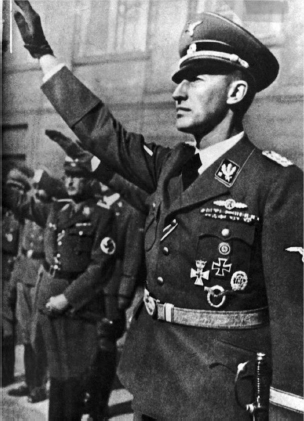
Reinhard Heydrich
Described by Hitler as the man with the iron heart, Reinhard Tristan Eugen Heydrich was chief of the Reich Main Security Office, which included the Gestapo, and founder of the Sicherheitsdienst (or SD, the intelligence agency of the SS). Born in 1904, he was handed control of the Gestapo by Heinrich Himmler in 1934. One of Heydrichs first operations was the Night of the Long Knives, when some 200 members of the rival paramilitary Sturmabteilung (SA) force, including its leader Ernst Rhm, were executed.
Heydrich set about organizing the Gestapo into a national and international instrument of terror. He established a system of colour-coded index cards for keeping information and monitoring the movements of perceived enemies of the Nazi state. He also instigated the so-called Night and Fog disappearances of persons endangering German security. Through such actions, the words Gestapo and terror would become synonymous.
In 1942 Heydrich chaired the infamous Wannsee Conference, which formalized plans for the Final Solution, or Holocaust. Shortly afterwards, he was assassinated by a team of British-trained Czech and Slovak soldiers. He was buried with full military honours, though Hitler railed in private that Heydrich had been stupid and idiotic for driving around in an unarmoured open-top car. At least 1,300 people were massacred by the Gestapo in retaliation for Heydrichs murder.
One of Gring and Himmlers first tasks had been to imbue the political police force that they inherited which was subject to judicial review and staffed by criminal investigators concerned with protecting the German state rather than any political party with a Nazi ideology. Through Heydrich, they espoused the view that since the Nazi party represented the German people, defending the interests of the party was the same as defending the interests of the people. The Gestapos key legal counsel, Werner Best, described the organization as a doctor to the German body, keeping a watchful eye on any symptoms that might lead to the nation becoming sick. It was a stroke of genius, allowing the Nazis to imply that the life and death of the German people were in the hands of the Gestapo. The political police were no longer to be viewed as investigators of crimes but as protectors of the nations well-being.
Initially, the spine of the Gestapo was recruited from the Prussian political police, and had a modest size of around 1,000 employees. Regional Gestapo offices tended to be located in dense urban areas or at key strategic border zones. There were 64 such offices at the outbreak of the war. The number increased as the Reich expanded into new territories, but there was also a drive to centralize authority, so many smaller regional offices were merged together. For this reason the total number of Gestapo offices remained in the dozens rather than the hundreds, even at the height of the Reich.
In terms of personnel, the organization grew rapidly throughout the 1930s: there were an estimated 6,500 Gestapo officers across the Reich by 1937. The outbreak of war brought a new urgency to the expansion process and the number of officers swelled to 15,000 by late 1941. The sheer size of the organization necessitated a radical restructuring, and Himmler used the opportunity to further strengthen the ties between the Gestapo and the SS by bringing them together in a single building. Hence the RSHA opened in September 1939.
Font size:
Interval:
Bookmark:
Similar books «Gestapo : Hitlers Secret Terror Police»
Look at similar books to Gestapo : Hitlers Secret Terror Police. We have selected literature similar in name and meaning in the hope of providing readers with more options to find new, interesting, not yet read works.
Discussion, reviews of the book Gestapo : Hitlers Secret Terror Police and just readers' own opinions. Leave your comments, write what you think about the work, its meaning or the main characters. Specify what exactly you liked and what you didn't like, and why you think so.

